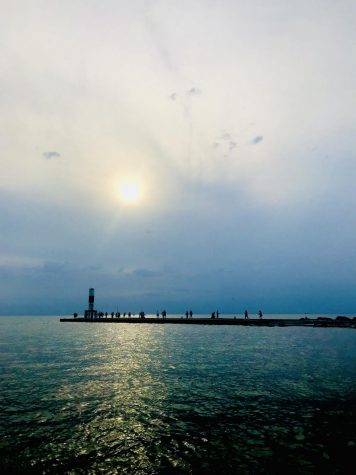What’s at stake with our great lake
September 30, 2021
They’re in denial. He’s five years old and missing at Holland State Park. We’ve spent hours searching in the towering woods that open up to the campgrounds crowded with cookouts and parties. We drove down Lake Michigan Avenue and parked. We got out and shouted the young boy’s name, but it’s getting dark and there’s still no sight of him. We encountered others searching for him too. His parents say he’s not in the water.
After all those hours spent searching, his small lifeless body is in fact in the water. They couldn’t have imagined the currents of the water took their five-year-old son, yet they did. He was only five, and he’s gone. Lake Michigan isn’t forgiving. Losing a child is unimaginable; losing a child to the thrills of Lake Michigan is tragic.
Michiganders usually choose to live in Michigan because of the Great Lakes. Thought to offer risk-free summer fun, the Great Lakes actually offers false geographical security. People create the idea that lakes are smaller and therefore less dangerous than the ocean. In reality, Lake Michigan presents just as much danger as an ocean, if not more.
idea that lakes are smaller and therefore less dangerous than the ocean. In reality, Lake Michigan presents just as much danger as an ocean, if not more.
Growing up near Lake Michigan meant sirens frequently disrupted my family’s summers. Sirens go by, and my mom gives me that look that’s full of sorrow and repeated tragedy. Another person’s lost in the lake. I have never been allowed to jump off the pier; I will never jump off the pier.
Federal law prohibits the practice of pier jumping, but most people don’t recognize the exhilarating act as an illegal one. Many people jump from the pier for a thrilling experience that gives them a sense of immortality as if they can do anything.
“Jumping off the pier is so fun because you get the adrenaline and you are able to say ‘I have jumped off the pier too,’” Jr. Zara Serrano said. Of 206 West Ottawa students polled, 24.8% have jumped off the pier. That’s to say that 24.8% of these students have broken federal law and potentially risked their lives in doing so.
Though the act of jumping isn’t uncommon, one local DNR officer, who has handled several state park situations concerning pier jumping, has even said that he himself jumped off the pier in his hometown of Sheboygan, Wisconsin where the pier’s much longer and further from shore.
According to the DNR officer, people find jumping off the pier as a youthful source of fun. People jump because they feel young and invincible. But when we’re young, are we as invincible as we think? Absolutely not. Everyone who jumps off the pier has the potential to drown regardless of skill and water conditions.
To drown is something a person can only experience at their last moment. For Sr. Bryan Stegenga, drowning’s something that has come too close to home. In the Spring of 2015, Stegenga spent time in Alabama and had a terrifying encounter with the dangers of water. “It was just clear, sunny weather. Waves were rolling in the ocean. Everything was pretty great,” Stegenga said. With no warnings on a perfect day, Stegenga assumed that the water was safe in the clear ocean, but even perfect conditions can harbor dangerous currents.
“The main issue with swimming in the ocean is that the ocean is its own thing. It moves on its own, there’s no way to predict it. What occasionally happens are these phenomena called undertows, where it will just drag you out into the ocean and the only way to escape – most people swim against it and try to swim straight back, but you can’t do that. You have to swim out of the undertow and then back to shore. So it was definitely like a scary moment. But, I had read pamphlets that were given to us at the lodge, so I was able to navigate my way out of the undertow and not succumb to it,” Stegenga said.
The same unpredictability of the water that Stegenga experienced is applicable to Lake Michigan. Rip currents, similar to undertows, have significance in lake Michigan, especially around the pier.
For Stegenga, the battle with the undertow has perpetually affected him. “I don’t really go in the water as much and I’m far more mindful of my surroundings. I don’t just take things at face value. I’ve always been pretty apprehensive, but definitely now more so than before,” Stegenga said. Stegenga’s close encounter with near-drowning changes how he views swimming. Requiring a close encounter to open the eyes of WOHS students and other beneficiaries of the lake is ridiculous and concerning.
But that was the ocean in Alabama. How does that apply to Lake Michigan? The ocean’s a clear, unaffected body of water in that situation. Lake Michigan isn’t unaffected. There’s a large pier that extends far out from the shore, surrounded by jagged rocks. With Lake Michigan, currents have a much greater prevalence than in the ocean.
“The pier is surrounded by large rocks under the water that at times are not visible from the surface and can cause serious injury,” Deputy Mike Dewitt said. These rocks surrounding the pier “bring additional danger to the waves and structural currents that are present,” Dewitt said.
Jumping off the pier isn’t ever a good idea. Dewitt said that there aren’t any precautions that can make pier jumping safer. “The construction and materials needed to make the pier useful make jumping from them dangerous,” Dewitt said. The popularity of pier jumping has become an alarming source of many deaths for young members of our community.
Drownings in the Great Lakes have been tracked since 2010 by The Great Lakes Surf Rescue Project. In the last decade, drownings have been fluctuating by year, varying from a low of 54 drownings in 2014 to a high of 117 drownings in 2018.
A majority of these drownings are because of the popularity of pier jumping and the lack of knowledge jumpers and swimmers alike have on the routine in order to escape rip currents, undertows, and the grueling conditions of the unpredictable lake. “Currents around piers can happen very quickly, and swimmers may not realize they are caught in a rip current until it’s too late,” Dewitt said.
A majority of drownings occurring in the Great Lakes happen in Lake Michigan. Statistics from The Great Lakes Surf Rescue Project show that since 2010, 1,017 people have drowned in the Great Lakes. Last year, 56 people drowned in Lake Michigan and since 2021 began, 35 people have drowned in Lake Michigan, but the year isn’t over yet.
These alarming numbers should stand out to Michiganders, especially Holland locals, because so many children, teens, and young adults jump and risk their lives for fun. If people already don’t know how to escape a current while swimming, then jumping from a pier further limits the chance a person has of surviving the currents that circulate around the pier.
Due to large numbers of people jumping off the pier, Park Township, the DNR office, and the Army Corps of Engineers created new guidelines for the pier. “Beginning May 1st, the staff at Holland State Park will monitor and open/close the pier gate on a daily basis. When the swim zone is established, they will monitor wave conditions and close the gate if one out of every three waves wash over the north pier. Once the swim zone is established or the flag system is in place, they will also close the gate when red flag conditions exist, even if no waves wash over the pier. They will also be closing the gate nightly when the park closes. In the morning if conditions are calm, they will open the gate when the park opens. This will continue until October 1st, at which time the gate will close for the season and remain closed,” Dewitt said.
Dewitt is a deputy for the Ottawa County Sheriff’s Office and a diver for the Ottawa County Dive Team. He has been a member of the Ottawa County Dive Team since 2012 and has taken part in several recovery operations.
“I have never jumped off the pier for fun. I have had to conduct dive operations next to the pier for search and rescue incidents, and for training. These dives always prove extremely challenging due to all the currents and different objects beneath the surface,” Dewitt said. Dewitt’s longest search for a drowning victim lasted four days.
“Each drowning has an effect. All of us on the dive team want to bring closure to the family/ friend for their missing loved one,” Dewitt said.
“I plead with everyone not to jump off the piers. Pier jumping is extremely dangerous and is a violation of federal law. The rocks, metal, and wood that are hidden just below the surface of the water can cause serious injury. The piers have strong currents surrounding them and were never designed to have people jumping off of them. Please respect Lake Michigan and stay out of the water during red flag conditions, and stay off of the piers in bad weather,” Dewitt said.
“Jumping off the pier is so fun,” said Serrano, Jr. and pier jumper. There’s no denying the adrenaline rush a person gets from jumping induces a euphoric feeling of invincibility that makes the act so fun. Fun isn’t a reason to die or risk dying.
For Stegenga, an undertow dragged him away on a perfect day. Even on perfect days, the water can still contain dangerous currents. “My friends and I always check the color of the flag before jumping,” Serrano said. Paying attention to flag colors and warnings is an extremely important part of water safety, but even with a green flag suggesting the water’s safe, currents still exist around the pier.
There’s a single reason to jump off the pier, but there are a plethora of reasons not to jump. “Don’t jump off the pier, it’s stupid. If it can happen in an ocean, it can happen in a lake,” Stegenga said. Stegenga had a firsthand account of the dangers that any body of water can impose. A clear ocean with no obstacles posed harm, therefore a rigid lake filled with rocks that encase a large pier can certainly pose a threat.
West Ottawa students shouldn’t suffer the consequences of jumping off the pier. Once we lose a student, they’re gone forever. Considering how many WOHS students consider themselves frequent jumpers, we should alert these students of the dangers. Health classes should teach how to free oneself from strong currents and the legality of pier jumping.
Local schools in areas like ours where the lake has a powerful presence in our lives, we should take precautions with students to discourage these behaviors to prevent drownings and the grief that comes with the loss of these people. Dewitt, along with a local DNR officer, said that they definitely support the idea that water safety incorporated into health classes would make a difference in saving lives.
Considering that 24.8% of polled WOHS students risk their lives jumping from the pier, the ignorance that comes with youth, especially amongst our student body, has become a problem. People should regard jumping off the pier as a threat and danger to young persons in local areas.












